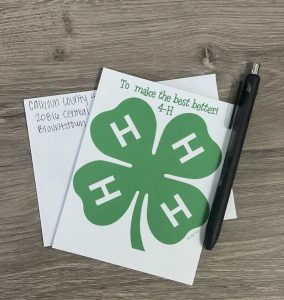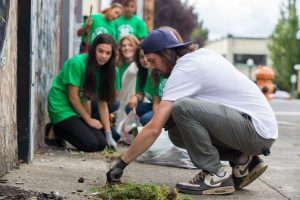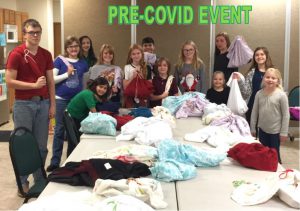by Heather Kent | Jan 13, 2023
Did you know that MLK Day is the only federal holiday designated by US Congress as a national day of service? Instead of a “day off” from school or work, Americans are encouraged to spend the day serving others. Coretta Scott King said:
“The greatest birthday gift my husband could receive is if people of all racial and ethnic backgrounds celebrated the holiday by performing individual acts of kindness through service to others.” MLK Day is always the third Monday of January.
In honor of Dr. Martin Luther King, Jr.’s legacy of service, this blog post brings together several resources to support 4-H service projects to live out our motto, “make the best better.”
What is the Difference Between Service Learning and Community Service?
Service to the community is one of the pillars of 4-H membership. Our pledge includes “My HANDS to larger service.” All 4-H members and clubs are encouraged to plan and execute at least one service project each year. Community service and service learning are often confused. Community service can be court-mandated and sometimes has a negative connotation. However, the biggest difference between community service and service learning is that community service is usually a “one and done” activity where youth collect food, clothes, or other items for a local organization or pick up litter. There is nothing wrong with these types of activities, but youth usually have little input on them, and they are one-time events. This is perfect for younger youth. In contrast, service learning is a longer-term process where youth identify a community need, develop a proposal or plan to address that need, and often involve other community organizations or officials to take action. Service learning is a great way for older youth and teens to develop awareness and empathy. For more information about the differences between service learning and community service, check out our previous blog post.
Getting Youth Involved in Service to Others
Service to others is a huge part of the 4-H Model. Not only is it part of our pledge, Generosity is one of the 4-H Essential Elements, and something we strive to integrate throughout our programming. 4-H Clubs are encourages to participate in at least one community service or service learning project each year- it one of many standards for club and individual members. If you are not familiar with standards of excellence, it is part of our 4-H Awards and Recognition Program. To learn more, check out this previous blog post or be sure to attend our workshop on Awards and Recognition next weekend at our Northwest 4-H Volunteer Forum.
Finally, there is a grant program to help clubs with service learning! It’s called 4-H Community Pride, and not only does this program provide funding for service learning, there is a comprehensive leader’s guide to help volunteers, youth, and parents plan, execute, and celebrate thier service learning.
Ideas to Kick Start Community Service or Service Learning
If you are in need of some fresh ideas for service learning, be sure to read “17 Ways to Kick Start Your Service Learning.” We will also offer a workshop on Service Learning during our Northwest 4-H Volunteer Forum next weekend in Destin, FL. Finally, during our upcoming Northwest 4-H Teen Retreat, youth will have the opportunity to participate in a service project our youth planning committee selected. They will be making teddy bears to give away at a summer camp for youth with disabilities.
by Claire Davis | May 6, 2022
 How do you know when it is appropriate to send a thank you card? Have you ever received a gift from someone? Did a volunteer donate their time for an event or for a club meeting? Are you in 4-H and someone purchased your project animal at auction? If you answered yes to any of these questions, then you should have written a thank you note to them! It does not just have to be a life changing event, such as a wedding, birthday, or baby shower, that warrants a thank you card. Whenever someone has done something nice for you, it is definitely worth sending them a thank you card.
How do you know when it is appropriate to send a thank you card? Have you ever received a gift from someone? Did a volunteer donate their time for an event or for a club meeting? Are you in 4-H and someone purchased your project animal at auction? If you answered yes to any of these questions, then you should have written a thank you note to them! It does not just have to be a life changing event, such as a wedding, birthday, or baby shower, that warrants a thank you card. Whenever someone has done something nice for you, it is definitely worth sending them a thank you card.
Writing thank you notes is a skill that many people should have, but many overlook. What exactly do you need to say in your thank you note? Here is an easy guide for a few things that you should include in your thank you note, regardless of the reason you are writing it!
Make sure that you start off by thinking of why you are writing a thank you note! Thank you notes let the individuals know that you care, that you are proud of your accomplishments, or make them feel appreciated for something that they have done for you!
-

A decorated academic cap at commencement. Photo taken 04-29-17.
Make the letter personal by starting with a salutation. Address the individual(s) by their name. If it is someone that you are well acquainted with, it is alright for you to address them by their first name. If it is someone that you are not as familiar with, stick to Mr., Mrs., Ms, and/or Miss last name. Below are a few examples of how to address someone:
Dear Aunt Renae,
Dear Lilly,
Dear Mr. and Mrs. Leonard,
- Get right to the point and express your gratitude. Some examples could be:
“Thank you so much for your generous wedding gift.”
“Thank you for the birthday present.”
“Thank you for donating your time at the Horse Club Meeting.”
“Thank you for purchasing my steer at the Calhoun County Livestock Show.”
- Maybe mention a specific detail or two. There is no need to exaggerate about their gift, but tell them what it might be used for or what you appreciate about it. Here are a few examples of things to say.
“I am so excited to get to use the birthday money on my upcoming trip to Disney World.”
“I’ve had my eye on a smoothie maker, and now I am a smoothie making machine!”
“We are saving the wedding money to help build our future home together.”
“The knowledge you shared at the meeting is incredibly valuable and the kids were soaking it up!”
“I am going to save the money from my 4-H steer project in my college fund.”
- Look ahead to the future. You may be excited about your trip to Disney World or the new smoothie machine, but make sure they know that you appreciate them or enjoyed working with them. If you are likely to spend time with them again in the future, this is a good way to move your letter towards wrapping up.***This suggestion may not apply to every letter.
“I can’t wait to have dinner with you again.”
“I’ll be up that way here in a few months and would love to see you.”
“I am interested in the position and look forward to hearing from you soon.”
“We cannot wait to have you teach us again at the club meeting next month.”
- Wrap it up with another thank you and sign off. Make sure that your letter is clear, you want to thank them for their time, donation, money, etc. You do not have to use fancy language to end your letter.
“Thank you again for thinking of us on our special day!”
“Thank you for being so generous to our organization.”
“Again, thank you for spending your time with us.”

Albert the Alligator Florida Gator mascot holding a thank you sign. Photo taken 11-16-16.
Make sure to end your letter appropriately, whether that be professionally or casually.
“Warmly,”
“With love,”
“Sincerely,”
When in doubt, write a thank you card. Your recipient will feel extra special that you want to show them your gratitude!
by Heather Kent | Jun 16, 2021

photo credit: National 4-H Council
One of the requirements for 4-H clubs to be chartered is annual participation in a service project because it helps youth develop compassion and empathy for others. This is an important step to help youth live our pledge “my heart to greater loyalty” and “my hands to greater service.” Recently, the terms community service and service learning are being used interchangeably, but they are not the same. This post will explain the difference between the two and provide additional resources for 4-H parents, volunteers and club officers.
What is community service?
Community service is usually a “one and done” activity. It is often associated with short term volunteerism, and sometimes can be associated with court-mandated sentences. Community service includes things like a food drive, clothing drive, or litter pick up. These types of activities help youth apply the “heart” and “hands” parts of our pledge, but youth typically do not organize the activities; they are often done in collaboration with another organization, such as Toys for Tots, a local food pantry, or Adopt a Highway. Community service is a great way to introduce the concepts of giving back to the community and helping others. It is very appropriate for our younger 4-H members, who don’t yet have the critical thinking, decision making, and leadership skills to execute a service-learning project.
What is service learning?
Service learning engages not only the “heart” and “hands” but also the “head.” Service learning is a process in which youth identify a need, develop solutions to address that need, implement a plan to put their solution into action, and reflect on the results of their action. Service learning should be planned and implemented by youth, with parents and volunteers supporting and guiding the process. Service learning is more appropriate for older youth who are ready to take on more responsibility. Service learning not only helps youth develop a sense of compassion, but it also helps them develop more independence.
So What’s the Difference?
For example, when a 4-H club decides to lead a food drive for the local pantry, they are contributing to the issue of food insecurity. Food drives are an effective way to meet the immediate need for more food, or more nutritious food. Our annual Peanut Butter Drive is a great way for 4-Hers to get involved with food insecurity; the Florida Peanut Producers match what is collected and everything is donated to a local food pantry. However, if youth want to address the issue of food insecurity in a more systemic way, they might choose to apply GPS technology to map the food deserts in their community or county. Next, they might present their findings to county commissioners or the chamber of commerce. Together, they brainstorm solutions on how to address food insecurity issues in those food deserts, but increasing awareness, or finding partners to provide sources of nutritious food. After implementing solutions, they look back and reflect on what they did, what worked, and what could be improved for next time.
Download this one-page document to help explain the difference between community service and service learning. This is a great resource for volunteers, parents and club officers. Next week, we will share ideas for service learning and community service related to a variety of issues, that can be a great discussion starter for your club meetings this fall!
If you have a passion for civic engagement and making a difference in your community, consider sharing your passion and skills with youth. We need volunteers to help youth understand what it means to be engaged in their community, and volunteers to empower youth to make a difference locally. We match volunteers’ skills and schedules with our program. Contact your local UF IFAS Extension Office for more information.
by Jena Gilmore | Dec 4, 2020

Care stockings for elderly residents.
Amid holiday season, one of the busiest times of the year, it’s a great opportunity to find ways to serve others. There are many activities that will allow you to safely relieve the fatigue of quarantine, virtual school and zoom meetings by getting into the spirit of giving through 4-H service projects.
Traditionally, community service projects would include a group of 4-H members banding together one day to clean yards for the elderly or visit nursing homes or volunteer at local shelters. Although COVID-19 limits many forms of our traditional service projects, youth and their families can still coordinate amazing opportunities amidst our new normal of social distancing. Remember, while participating in any 4-H affiliated programs or projects, all members, families, and volunteers must adhere to our safety protocols which include but are not limited to wearing masks the entire time, remaining 6-feet apart, hand sanitizing and washing regularly, and more found here.
Here are some safe alternatives to implement with your local 4-H program, club, or businesses:
- Power Hour Yardwork– If outside activities are your forte, have families sign up to clean one location together as a family unit. Remain masked, gloved, and wash hands regularly to ensure safety of yourself and others. Set obtainable goals for your one-hour timeframe to limit traffic and need for the use of facilities.
- Business Lawn Decorating- Some business, such as Elderly Rehabilitation Centers and Nursing Homes, allow outside groups to decorate the outside areas of their facilities for the holidays. This is a great way to show off your creative side and even drum up some friendly competition. Remember to follow UF COVID guidelines (wear masks, social distancing, etc).
- 4-H Care Stockings- Pack stockings with hygiene items, socks, word games, and/or prewrapped snacks and deliver them to long term care facilities or even local businesses. Be sure to include information on 4-H, whether it be a card, business card, or 4-H pledge bookmark! You never know where we may find new 4-H Volunteers or members.
- 4-H Book Buddies- Find a facility that would allow you to read a book (even better if you dressed in character) to their clientele. While this may not be feasible in person with COVID restrictions, offer to pre-record a session and either email or share the link!
- Food Drives- Set up a location (preferably at your 4-H office) for locals to donate unperishable items in containers that can be sprayed with disinfectant spray. Work with your 4-H Agent or other adults to set up where these items will be distributed to.
- 4-H Furever Gifts- Put those sewing (or tying) skills to good use and make some dog toys, blankets, or beds out of old t-shirts or jeans. These make perfect donation pieces to pet shelters and rescue facilities!
- 4–H Pen Pals- Contact your local elderly residential facilities to see if 4-H members could submit cards/letters to residents. Be sure to speak to someone in management to get approval for contact information. Another alternative to this would be to contact classroom teachers and ask if you can send a letter or card to the class. This would be a great way to recruit future 4-H’ers too as you share your own stories!

4-H’ers packed pillow case hygiene packs for residents at the Chautauqua Rehabilitation Center.
Service projects are an excellent method of targeting life skills in the “head and heart” areas of the targeting life skills model. Teaching our youth to care about others instills empathy while teaching them the spirit of giving activates community service volunteering. For more ways to volunteer in your county, check with you local 4-H office and seek ways that you can volunteer with 4-H today!
by pmdavis | Nov 10, 2020

Courtesy photo from https://media.defense.gov
When you think of military service, what words come to mind … training, deployments, relocation, freedom, service, and sacrifice? One word that most people overlook is… Family! According to National Child and Traumatic Stress Network “November was first declared as Military Family Month in 1996. Since then, November has been a time to acknowledge the tremendous sacrifices our military families make. They contend with separation from their families and make adjustments to new living situations and communities. Military Families embody strength, resilience, and courage. Care of military families and children sustains our fighting force, and strengthens the health, security, and safety of our nation’s families and communities.”
Help 4-H recognize the Military Family this month. Many of us live in a community with active duty military families, and almost every community has a Guard or Reserve family that you may not realize are service members. These individuals have a different job in the community and serve in times of need.
For those of us without a military background, it can be difficult to know how to be supportive. You may want to meet military family’s needs but don’t know where to begin. Therefore, we have put together a few ideas to help you on your supportive journey.
- Create something decorative to cheer up a veteran’s nursing home room. Picture, Mandala, Bookmark
- If you have a new military family come to your community welcome them to the neighborhood or school. Help them find their way around, give them a list of best places in your community and your phone number in case they need help.
- Leave a care package with family friendly activities and self-care items. Operation Gratitude and Operation Care & Comfort are two organizations that do this for military members.
- Volunteer to babysit or take a child to a practice and give the military parent a break especially if one of the parents is deployed. Just having someone they can trust offer help is a big gift!
- Volunteer your time to provide companionship, serve a meal, assemble holiday packages. Veterans’ advantage has a list of trusted organizations and nonprofits if you don’t have a person in mind.
- Deliver a meal or prepare something that they can take from the freezer and put in the oven or microwave as a quick meal.
- Send a thank you note expressing your appreciation for the family’s support of our Military.
- Offer to cut grass, clean, or help with household chores.
- Offer to run errands – doing a grocery run, picking up dry cleaning, and other errands can ease the burden of juggling responsibilities while a military member is deployed.
- Adopt a family for the holidays. Holidays can be hard when a service member is deployed or doesn’t have family in the local area. Include military families in your holiday plans – holiday dinners, festivals, baking, etc. If you do not have a family locally Soldier Angels can help you to adopt a family.
- Treat a service member or veteran to a holiday stocking filled with items to bring them some cheer. If you don’t have someone in your local area, Soldiers Angels Stockings For Heroes is a national organization doing this. https://soldiersangels.org/holiday-stockings-for-heroes/
- Offer to board a military family’s pet while the family goes on vacation or takes a trip. Dogs on Deployment or PACT Military Foster Program
- Donate to local or national military support programs or gift your airline miles to Hero Miles Program. It supports wounded, injured, and ill service members and/or their families who are undergoing treatment at a medical facility.
We hope you and your family will consider doing something to recognize our military families this month. Also, if you have a family with kids, take them to visit a war memorial and discuss the meaning of service and sacrifice, and that this is something to remind us of the people who served in and died as a result of war. Help them understand the sacrifices of our military families to make our lives better and ensure our basic freedoms. I have been told by friends who are military families that even the “little things” can make a big difference to a military family. Please join us in celebration of National Military Families Month by adopting or supporting a military friend or support organization in 2020.
Written by Jennifer Sims and Paula Davis








